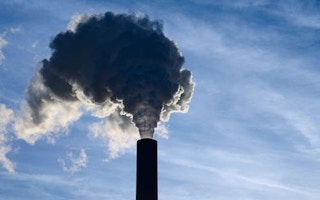The world will face a 50 per cent increase in greenhouse gas (GHG) emissions by 2050 without aggressive and effective policy changes, said an OECD expert on Wednesday.
Deputy director of the Environment Directorate for the Organisation for Economic Co-operation and Development (OECD), Helen Mountford, told reporters at an on-line media briefing that an OECD assessment of social and economic trends - outlined in its new OECD Environmental Outlook 2050 report – found that atmospheric levels of GHGs could reach nearly 685 parts per million, far above the target level needed to limit global warming to two degrees Celsius.
The increase in emissions will be driven by rising emissions from fossil fuel energy sources, whose percentage of the global energy mix will maintain its current level of about 85 per cent.
Unlike previous versions of the OECD report, the 350+ page report released on Thursday provided in-depth analysis of four areas relating to the environment - climate change, biodiversity, water and the health impacts of pollution.
Urban air pollution will take over from lack of sanitation as the world’s leading cause of premature deaths, due to a doubling of current numbers to reach 3.6 million deaths each year. Already, many Asian cities frequently exceed the safe levels for air pollution prescribed by the World Health Organisation and the problem is going to get worse, said Ms Mountford.
Other health impacts from pollution will come from the use of hazardous chemicals, which is rapidly expanding in the same developing countries that currently lack the training and facilities to handle them safely. Many of the health effects of such chemicals are not well understood, particularly when chemicals are mixed together in the environment, according to the report.
OECD’s baseline scenario also predicted that water demand will increase by 55 per cent globally due to growing demand from manufacturing, power generation and household use, and by 2050 another 2.3 billion people will be living in the world’s major river basins. The increase in population in those areas will result in over 40 per cent of the global population living in water-stressed areas.
Loss of biodiversity, expected to decline another 10 per cent from current levels, will for the first time be driven by climate change rather than by loss of habitat due to expanding agriculture and forestry.
The 2050 scenario from OECD is based on a projected global population of over nine billion, 70 per cent of which will live in cities. These factors will lead to a global economy – measured by world gross domestic product (GDP) – that will be nearly four times its current size.
Ms Mountford noted that the pressures on natural resources from growing populations and economies is outpacing the progress the world in making on environmental issues, and causing “irreversible damage” that threatens to undo centuries of economic growth.
“The report does paint a bleak picture,” but it also points to solutions to move the world onto more sustainable growth paths, noted Ms Mountford.
The report recommends six actions that countries can take to change course:
- Make polluting activities more expensive than non-polluting activities through economic tools such as environmental taxes and emission trading schemes;
- Find ways of pricing the benefits from natural resources, such as introducing water fees to pay for the protection of water sources and sanitation;
- Introduce effective regulations and standards to protect the environment, such building codes, vehicle emissions taxes and bans of dangerous substances;
- Remove government subsidies that have a damaging effect on the environment. For example, fossil fuel subsidies, which totalled about US$400 billion in 2010 according to the IEA, use up scarce government resources that could be better applied elsewhere;
- Increase support for research and development for clean technologies, policy innovations and technology transfer to developing countries; and
- Frequently assess all policies as a whole to ensure they work together effectively.
Ms Mountford stressed that policies would have to be customised for each individual country, and that countries would have to integrate environmental actions throughout government departments rather than just implementing them within environment ministries and agencies.
More importantly, environmental issues had to be looked at together because efforts to address one will impact others. For example, promoting clean energy will impact both climate change and air pollution positively - making it a cost effective solution - whereas subsidising biofuels may have a positive impact on GHG emissions, but a negative impact on biodiversity, she noted.
The “erosion of our environmental capital” will have direct costs and consequences not only for the environment, but for the economy and human welfare as well, she added.
Ms Mountford warned that policymakers should not delay environmental action, regardless of the economic troubles many countries are experiencing.
“We need to act and act now,” she said.

















